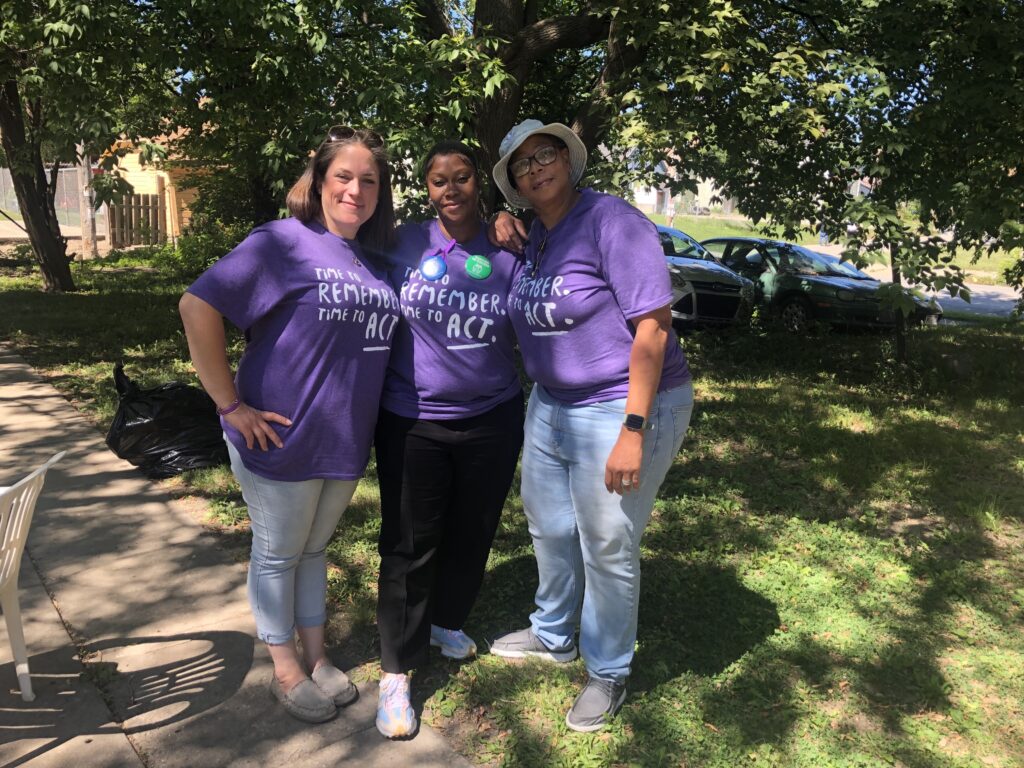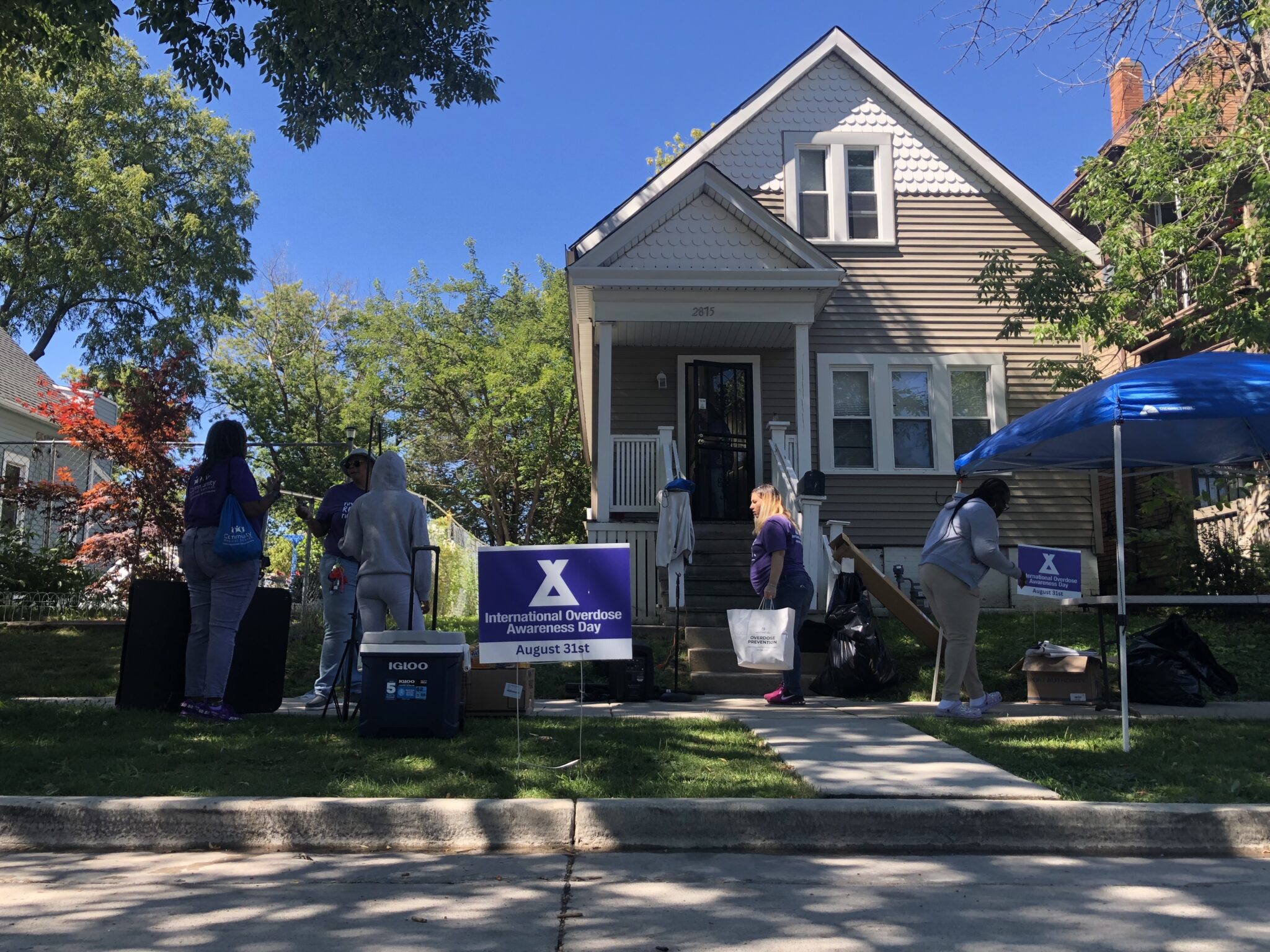On August 31, I spent time with people on the frontlines of the overdose crisis in Milwaukee, Wisconsin. Taking the PurpleLine bus through the city’s North Side to Locust Street, I arrived at Samad’s House, a sober living facility for women that doubles as a harm reduction outreach service.
This was the scene of one of hundreds of events taking place across the United States to mark International Overdose Awareness Day—and one notable for showing how members of the recovery community can be important advocates for harm reduction. I had previously met the people behind Samad’s House as they handed out naloxone during the city’s Juneteenth parade.
The street outside the house was blocked off, and people set up tables and chairs. Local organizations—including Milwaukee’s Office of African American Affairs, the city of Wauwatosa’s health department, Clean Slate Milwaukee and Advocate Aurora Health—staffed stands to distribute free resources. You could go grab Narcan kits, fentanyl test strips, condoms, water and snacks. Many people were wearing purple shirts, reading “Time to remember, Time to act.” People clipped purple ribbons with a white dove to their shirts.
Many of the hundred or so people in attendance were in recovery, meaning they choose to abstain from certain drug use after experiencing substance use disorder—some for short periods at a time, some continuously for decades. But they all professed a determination to break stigma against people who continue to use drugs.
It’s a welcome sign when estimates place the US recovery community at tens of millions strong—and when harm reduction and recovery are sometimes characterized as opposing mindsets, rather than different points on a continuum.
“Up until 76 days ago, when I found her deceased, I had Narcan in my home and didn’t know how to use it.”
Up front, speakers had begun sharing personal stories that informed the event.
One woman told us that she had struggled with addiction for 20 years, and recently became sober. “What got me into recovery was I lost my best friend due to a heroin overdose,” she said. “She passed away in my home on April 3 this year.”
“What bonded us together is we were both in domestic violence relationships,” she continued. “We had a lot of trauma … although we didn’t have a very long friendship, when I tell you she was my best friend, there is nothing in this world I would have not done for that girl.”
Her key point was powerfully made: “Up until 76 days ago—I’ve had 76 days of sobriety—when I found her deceased, I had Narcan in my home and didn’t know how to use it.”
“What causes overdosing?” asked Byron Thompson, of Wisconsin-based recovery group The Phoenix. His answer was simple: “Stigma.” He later told Filter how his organization provides a range of free activities for people in recovery, from rock climbing to painting.
“I have experienced stigma everyday,” said Christopher Zahn of Wisconsin Voices for Recovery, taking up the previous point. “At one point in my life—I’m going to use stigmatizing language—I was a homeless drug addict, alcoholic, ex-con.”
“But I’m not that person today,” he continued, going on to speak of his pride and gratitude in his recovery. “We are people, and we are all miracles of human beings and need to be treated as such.”
Amanda De León, integration manager at Community Medical Services, then gave everyone present training in how to use nasal-spray naloxone (Narcan). She talked about how to spot signs of overdose—discolored skin, slowed breathing, non-responsiveness—and how to position someone’s body and place the spray in their nose.
“This is a 4 milligram dose, it’s a lot,” she said. “It’s made for human error—you might not get all of it up there, and you might [not] be pressing on the way up.” De León said the best thing to do when you see someone overdosing is immediately dial 911, put the operator on speakerphone and start administering naloxone as you’re talking to them. She told everyone to try to be patient when dosing.
“You are supposed to wait a full three-to-five minutes before giving another dose,” she said. “We know it’s scary, it’s hard to do because your anxiety is going and you just want that person to live …giving chest compressions and getting that airway going, giving breaths into their mouth, will help.”
The devastating US overdose crisis shows little sign of relenting. In both 2021 and 2022, over 100,000 people died of overdose—the leading cause of accidental death, ahead of car crashes and firearms. The tragic impact differs dramatically along racial, class and other demographic lines, and deaths are rising rapidly in Black and Indigenous communities.
Milwaukee County is the eighth-hardest hit jurisdiction nationwide. The city of Milwaukee is an outlier in the state as well, with residents dying of overdose at more than twice the rate of all Wisconsin residents and US residents overall. Black Wisconsin residents have experienced the greatest increase in overdose rates of the last 20 years. And Samad’s House—located in the heart of Milwaukee’s Black community—helps fill an important need for harm reduction education and resources, as well as recovery support.
As the event came to an end, I joined volunteers in helping to pack and clean up the tents and other supplies. Tahira Malik, founder of Samad’s House, invited me inside to talk. Among other things, I asked her what is the biggest economic barrier facing people in recovery in her community.

“Long-term housing,” she said immediately. “The worst thing we can do to a person trying to rebuild their life is put a time clock over their head. How can you really heal when you know your [housing support] will run out in 90-100 days?”
Malik herself previously experienced substance use disorder, and built the house that we were both sitting in to give back to people walking the same path. But while operating a sober house, she goes out every Monday to do outreach in the streets of Milwaukee, distributing free harm reduction supplies to people in need.
“The reality is, everyone is not ready to come into recovery yet. Watching so many of our loves ones pass from drug overdose fuels our fire.”
She told me she was recently proud to see one of her “ambassadors”—a resident who had been in recovery for six months—save someone’s life with naloxone.
Malik leads a busy life, and her phone soon started ringing. But before we headed outside, she explains what drives her determination to promote harm reduction from her position in the Milwaukee’s recovery community.
“We want everyone in recovery because we know how wonderful [it is] and how your life simplifies,” Malik said. “But the reality is, everyone is not ready to come into recovery yet, and we are continually losing people because of the War on Drugs. So watching so many of our loves ones pass from drug overdose fuels our fire, to maintain sobriety but also go out into the community and let them know there’s resources to save their lives.”
All photographs provided by author





Show Comments